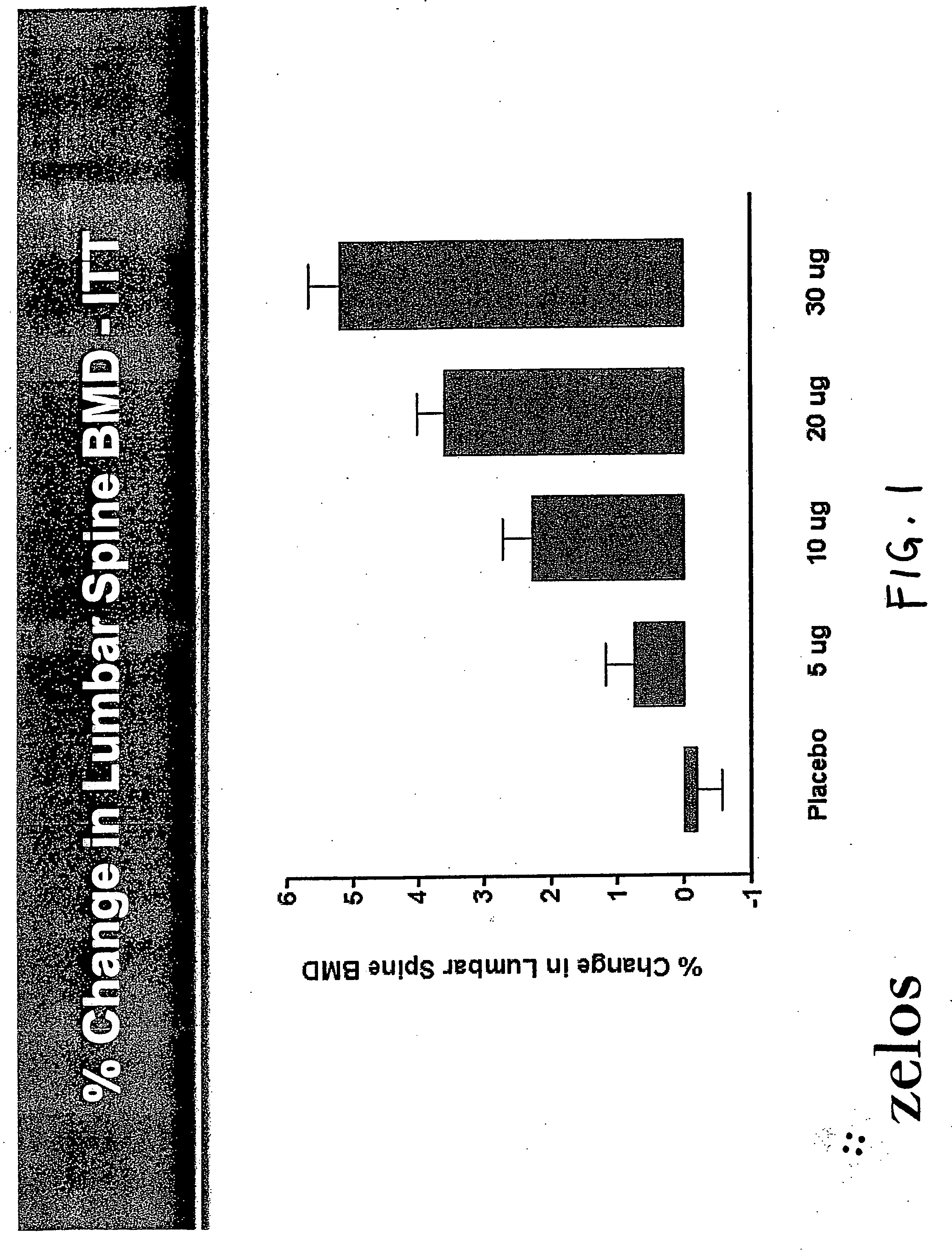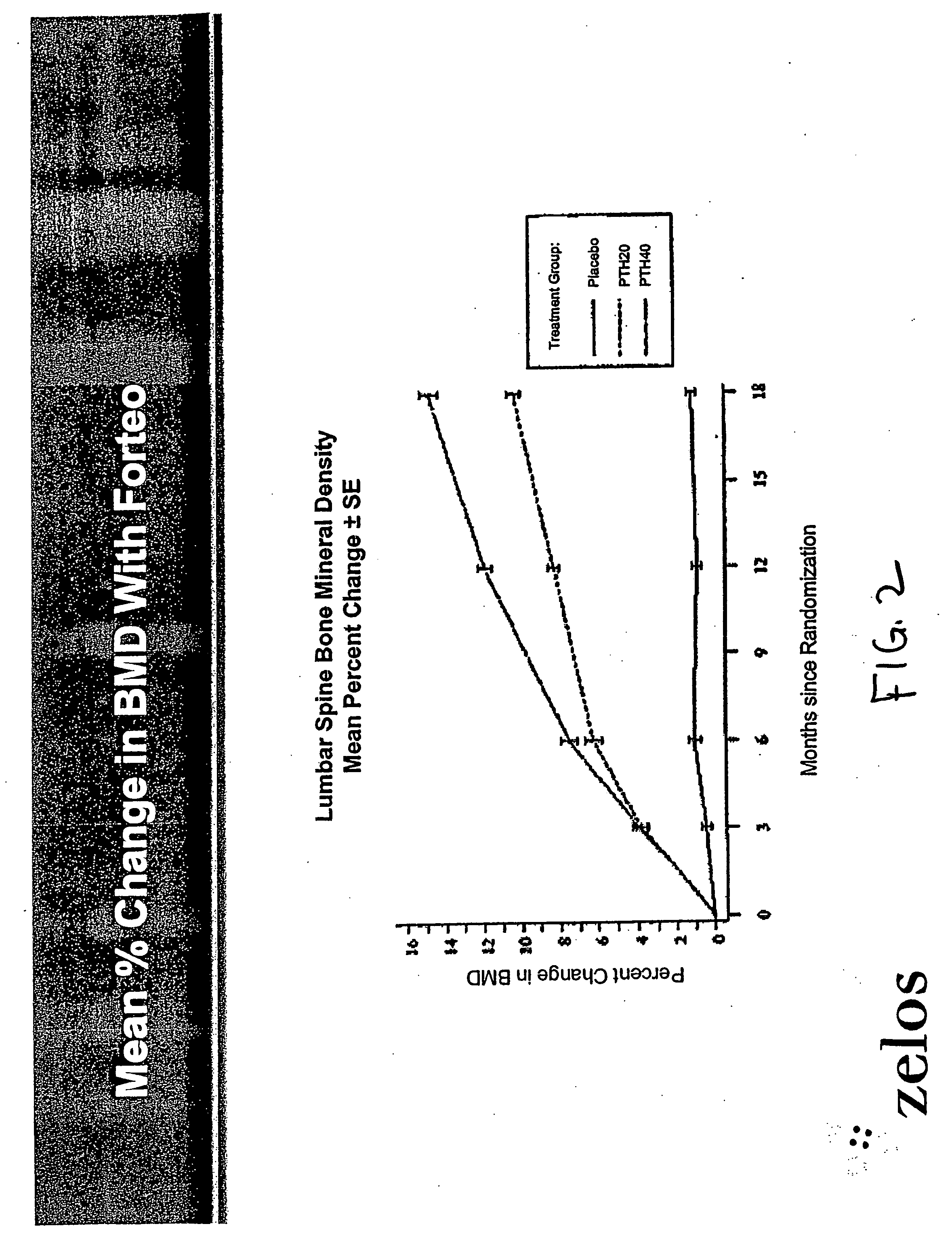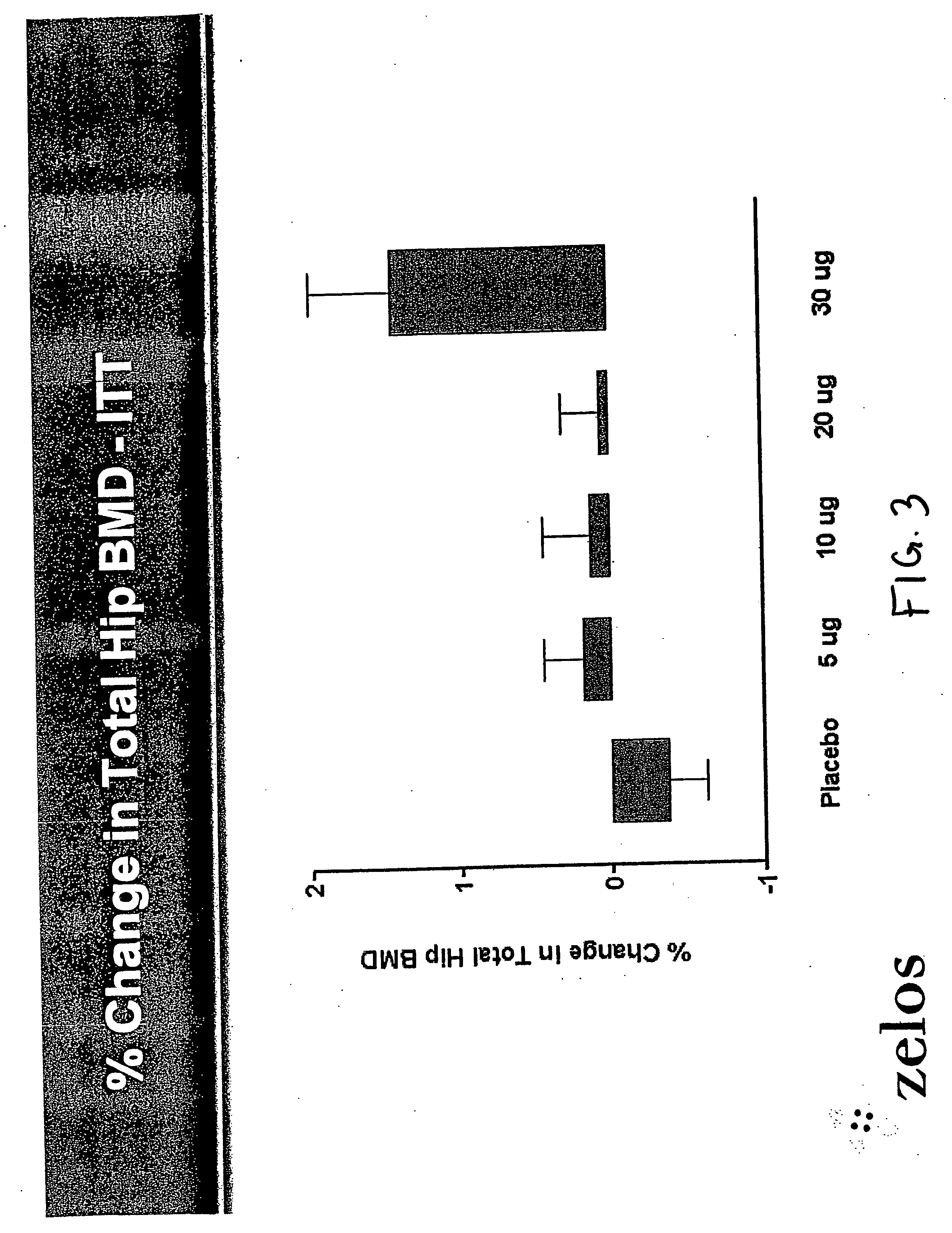Parathyroid hormone analogues and methods of use
a technology of parathyroid hormone and analogues, which is applied in the field of parathyroid hormone analogues and methods of use, can solve the problems of increased fracture risk, weak bones, heaviness (mass), etc., and achieves the effects of restoring bones, less bone resorption, and increasing bone mineral density
- Summary
- Abstract
- Description
- Claims
- Application Information
AI Technical Summary
Benefits of technology
Problems solved by technology
Method used
Image
Examples
example 1
Synthesis and Purification of [Leu27]cyclo[Glu22-Lys26]-hPTH-(1-31)-NH2
[0165] This peptide was synthesized and purified as described in U.S. Pat. No. 5,955,425, the teachings of which are incorporated herein by reference, with Lys-Alloc and Glu-OA11 substituted at position 26 and 22, respectively. After the addition of Fmoc-Ser17, the peptide-resin was removed from the column to a reaction vial (Minivial, Applied Science), suspended in 1.7 ml of a solution of tetrakis(triphenylphosphine)palladium(0) (0.24 mmol), 5% acetic acid and 2.5% N-methylmorpholine (NMM) in dichloromethane (DCM) under argon, then shaken at 20° C. for 6 hr to remove the allyl and alloc protecting groups (Solé, N. A. et al (1993) In Peptides: Chemistry, Structure, and Biology, Smith, J. And Hodges, R. (Eds), ESCOM pp. 93-94, incorporated herein by reference). The peptide resin was then washed with 0.5% diethyldithiocarbamate (DEDT), 0.5% NMM in DMF (50 ml), followed by DMF (50 ml) and DCM (50 ml). The peptide (...
example 2
[Leu27]cyclo[Glu22-Lys26]-hPTH-(1-31)-NH2 Promotes Growth in Both Trabecular and Cortical Bones in a Monkey Model
[0167] The peptide [Leu27]cyclo[Glu22-Lys26]-hPTH-(1-31)-NH2 Ostabolin-C™ was administered daily by subcutaneous injection to gonad-intact cynomolgus monkeys (4 / sex / group) at dose levels of 0, 2, 10 and 25 μg / kg for 52 weeks. Monkeys were 30 to 40 months of age (2.3-3.5 kg) at treatment start. Tibiae were retained for histomorphometry following labeling with calcein green 15 and 5 days prior to euthanasia. Bone mass, as measured by DXA (dual-energy x-ray absorptiometry) and QCT (quantitative computed tomography), was increased at the lumbar spine, femur and tibia. Changes in vertebral BMD (bone mineral density) translated into significant increases in bone strength. The peptide [Leu27]cyclo[Glu22-Lys26]-hPTH-(1-31)-NH2 substantially increased osseous accretion in the cancellous and endocortical bone compartments of the proximal tibia at all doses. Tibial cancellous bone ...
example 3
Pre-Clinical Cortical Porosity Data
[0168] Comparative data regarding increase in cortical bone porosity in monkey subjects using Ostabolin C at a variety of doses and using the prior art PTHs 1-34 is shown below.
% CorticalStudyMoleculeModelSiteM / FDosePorosityReferenceOstabolin-CGonadTibialMControl3.4 ± 0.89Zelosintact youngMid- 2 μg / kg / day4.2 ± 0.29Cynomolgus monkeysDiaphysis10 μg / kg / day5.1 ± 1.08treated daily25 μg / kg / day8.0 ± 5.54for 12 monthsGonadTibialFControl2.0 ± 0.32Zelosintact youngMid- 2 μg / kg / day2.5 ± 0.41Cynomolgus monkeysDiaphysis10 μg / kg / day2.6 ± 0.85treated daily25 μg / kg / day3.2 ± 0.87for 12 monthsOstabolin-CGonadTibialMControl3.5 ± 1.18Zelosintact youngMid-10 μg / kg / day3.7 ± 0.70Cynomolgus monkeysDiaphysis25 μg / kg / day5.8 ± 1.82treated dilay16.4 ± 7.14*for 6 weeks80 μg / kg / dayGonadTibialFControl3.3 ± 0.90Zelosintact youngMid-10 μg / kg / day3.2 ± 0.97Cynomolgus monkeysDiaphysis25 μg / kg / day4.0 ± 1.25treated dilay10.6 ± 0.35 for 6 weeks80 μg / kg / dayPTH 1-34OVX adultHumerusFCon...
PUM
| Property | Measurement | Unit |
|---|---|---|
| concentration | aaaaa | aaaaa |
| concentration | aaaaa | aaaaa |
| concentration | aaaaa | aaaaa |
Abstract
Description
Claims
Application Information
 Login to View More
Login to View More - R&D
- Intellectual Property
- Life Sciences
- Materials
- Tech Scout
- Unparalleled Data Quality
- Higher Quality Content
- 60% Fewer Hallucinations
Browse by: Latest US Patents, China's latest patents, Technical Efficacy Thesaurus, Application Domain, Technology Topic, Popular Technical Reports.
© 2025 PatSnap. All rights reserved.Legal|Privacy policy|Modern Slavery Act Transparency Statement|Sitemap|About US| Contact US: help@patsnap.com



